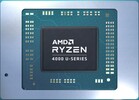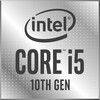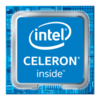AMD Ryzen 7 4700U vs Intel Core i5-10210U vs Intel Celeron 5305U
AMD Ryzen 7 4700U
► remove from comparison
The AMD Ryzen 7 4700U is a processor for thin and light laptops based on the Renoir architecture. The 4700U integrates all eight cores based on the Zen 2 microarchitecture. They are clocked at 2 (guaranteed base clock) to 4.1 GHz (Turbo). There is no support for the thread-doubling SMT tech. The chip is manufactured on the modern 7 nm TSMC process and partly thanks to it AMD advertises a 2x improved performance per Watt for the Renoir chips. Compared to the faster R7 4800U, the 4700U offers slightly lower clock speeds and no support for SMT / Hyperthreading.
In addition to the eight CPU cores, the APU also integrates a Radeon RX Vega 7 integrated graphics card with 7 CUs and up to 1600 MHz. The dual channel memory controller supports DDR4-3200 and energy efficient LPDDR4-4266 RAM. Furthermore, 8 MB level 3 cache can be found on the chip. See our hub page on the Renoir Processors for more information.
Performance
The average 4700U in our database proves to be a rather competent little processor. It trades blows with the much more power-hungry Intel Core i7-10750H, as far as multi-thread benchmark scores are concerned. While it fails to get far enough away from the more affordable Ryzen 5 4600U, this Ryzen 7 is still a good CPU for most tasks.
Your mileage may vary depending on how competent the cooling solution of your laptop is and how high the CPU power limits are.
Power consumption
The Ryzen 7 4700U is a 15 W chip. However, laptop makers are allowed to change that value to anything between 10 W and 25 W, with clock speeds and long-term performance changing accordingly as a result. By going for the lowest value, it is possible to build a passively cooled system around the APU.
The fairly modern 7 nm TSMC process this Ryzen is manufactured on makes for above average, as of mid 2022, energy efficiency.
Intel Core i5-10210U
► remove from comparison
The Intel Core i5-10210U is a power efficient quad-core SoC for notebooks based on the Comet Lake (CML-U) generation and was announced in August 2019. Compared to the similar Whiskey Lake processors (e.g. Core i5-8665U), the only difference is support for higher memory speeds (up to LPDDR4-2933 vs DDR4-2400) and two additional cores in the top model (not in this i5). The processor cores are clocked between 1.6 and 4.2 GHz (all 4 cores 3.9 GHz max). Thanks to Hyper-Threading 8 threads can be used. Compared to the faster i5-10510U, the level 3 cache was reduced from 8 to 6 MB. More information on Comet Lake and all the models and articles on it can be found here.
The integrated graphics adapter however is still the same as in the previous generations. It's still called Intel UHD Graphics 620 and clocked from 300 - 1100 MHz in the i5. Furthermore, the SoC integrates a VP9 and H.265 de- and encoder.
Performance
The average 10210U in our database is just as fast as the AMD Ryzen 5 2500U, the Intel Core i7-8565U and the Intel Core i5-1035G1 are, as far as multi-thread benchmark scores are concerned. While the i5 is not a performance monster, it sails through basic day-to-day workloads with little effort.
Thanks to its decent cooling solution and a long-term power limit of 30 W, the Frost Canyon NUC (NUC10i5FNK) is among the fastest systems powered by the 10210U that we know of. It can be more than twice as fast in CPU-bound workloads as the slowest system featuring the same chip in our database, as of August 2023.
Power consumption
This Core i5 series chip has a default TDP, also known as the long-term power limit, of 15 W, a value that laptop makers are free to change to anything between 10 W and 25 W with clock speeds and performance changing accordingly as a result. By going for the lowest value, it is possible to build a passively cooled system around the i5. Please note that Comet Lake-U processors can briefly consume as much as 80 W or even 90 W when under heavy loads.
The Core i5-10210U is built with one of the old 14 nm Intel processes for very low, as of mid 2023, energy efficiency.
Intel Celeron 5305U
► remove from comparison
The Intel Celeron 5305U is a low-power dual-core SoC for laptops, based on the Comet Lake architecture, which was introduced in 2020. Compared to Kaby Lake and Whiskey Lake, there are apparently no differences with Comet Lake apart from the two additional cores in the Top model Core i7-10710U. The processor is still manufactured using the mature 14nm process (14nm++ like Whiskey Lake). The processor cores clock at a fixed 2.3 GHz (no Turbo) and also only offer 2 threads (no HyperThreading). Compared to the more powerful Core i3, i5 and i7 variants, the Celeron does not offer SSE (2) support.
You can find more information about the Comet Lake architecture and the available processors on our Comet Lake topic page.
According to Intel, the integrated graphics card is called Intel UHD Graphics, but is an old Intel UHD Graphics 610. It is clocked in the Celeron 5205U at 300 - 900 MHz and is only sufficient for very demanding games. The CPU also offers an integrated DDR4-2666 / LPDDR4x 2933 / LPDDR3-2133 dual-channel memory controller as well as VP9 and H.265 video decoder and encoder.
Performance
The performance of the Celeron 5305U is in the lowest entry-level class of notebook processors in 2020. Due to the lack of Turbo and only 2 cores, the CPU cannot score points in either single-core or multi-core tasks. The processor is therefore only suitable for undemanding tasks such as surfing with a few tabs and office tasks.
The power consumption and performance can be set from 15 to 12.5 watts by the notebook manufacturer via cTDP-down. However, the processor then only runs at 800 MHz and significantly reduced performance. Even at 15 watts, however, the processor is suitable for thin and light notebooks.
| Model | AMD Ryzen 7 4700U | Intel Core i5-10210U | Intel Celeron 5305U | ||||||||||||||||||||||||||||||||||||||||||||||||||||||||||||||||||||||||||||||||||||||||||||||||||||||||||||
| Codename | Renoir-U (Zen 2) | Comet Lake-U | Comet Lake-U | ||||||||||||||||||||||||||||||||||||||||||||||||||||||||||||||||||||||||||||||||||||||||||||||||||||||||||||
| Series | AMD Renoir (Ryzen 4000 APU) | Intel Comet Lake | Intel Comet Lake | ||||||||||||||||||||||||||||||||||||||||||||||||||||||||||||||||||||||||||||||||||||||||||||||||||||||||||||
| Series: Comet Lake Comet Lake-U |
|
|
| ||||||||||||||||||||||||||||||||||||||||||||||||||||||||||||||||||||||||||||||||||||||||||||||||||||||||||||
| Clock | 2000 - 4100 MHz | 1600 - 4200 MHz | 2300 MHz | ||||||||||||||||||||||||||||||||||||||||||||||||||||||||||||||||||||||||||||||||||||||||||||||||||||||||||||
| L1 Cache | 512 KB | 256 KB | |||||||||||||||||||||||||||||||||||||||||||||||||||||||||||||||||||||||||||||||||||||||||||||||||||||||||||||
| L2 Cache | 4 MB | 1 MB | |||||||||||||||||||||||||||||||||||||||||||||||||||||||||||||||||||||||||||||||||||||||||||||||||||||||||||||
| L3 Cache | 8 MB | 6 MB | |||||||||||||||||||||||||||||||||||||||||||||||||||||||||||||||||||||||||||||||||||||||||||||||||||||||||||||
| Cores / Threads | 8 / 8 | 4 / 8 | 2 / 2 | ||||||||||||||||||||||||||||||||||||||||||||||||||||||||||||||||||||||||||||||||||||||||||||||||||||||||||||
| TDP | 15 Watt | 15 Watt | 15 Watt | ||||||||||||||||||||||||||||||||||||||||||||||||||||||||||||||||||||||||||||||||||||||||||||||||||||||||||||
| Technology | 7 nm | 14 nm | 14 nm | ||||||||||||||||||||||||||||||||||||||||||||||||||||||||||||||||||||||||||||||||||||||||||||||||||||||||||||
| max. Temp. | 105 °C | 100 °C | 100 °C | ||||||||||||||||||||||||||||||||||||||||||||||||||||||||||||||||||||||||||||||||||||||||||||||||||||||||||||
| Socket | FP6 | BGA1528 | BGA1528 | ||||||||||||||||||||||||||||||||||||||||||||||||||||||||||||||||||||||||||||||||||||||||||||||||||||||||||||
| Features | DDR4-3200/LPDDR4-4266 RAM, PCIe 3, MMX, SSE, SSE2, SSE3, SSSE3, SSE4A, SSE4.1, SSE4.2, AVX, AVX2, BMI2, ABM, FMA, ADX, SMEP, SMAP, CPB, AES-NI, RDRAND, RDSEED, SHA, SME | LPDDR3-2133/DDR4-2666/LPDDR4-2933 RAM, PCIe 3, 4 GT/s bus, MMX, SSE, SSE2, SSE3, SSSE3, SSE4.1, SSE4.2, AVX, AVX2, BMI2, ABM, FMA, ADX, VMX, SMEP, SMAP, MPX, EIST, TM1, TM2, Hyper-Threading, Turbo, SST, AES-NI, RDRAND, RDSEED, SGX | LPDDR3-2133/DDR4-2400 RAM, PCIe 2, 4 GT/s bus, MMX, SSE, SSE2, SSE3, SSSE3, SSE4.1, SSE4.2, AVX, AVX2, BMI2, ABM, FMA, ADX, VMX, SMEP, SMAP, MPX, EIST, TM1, TM2, SST, AES-NI, RDRAND, RDSEED, SGX | ||||||||||||||||||||||||||||||||||||||||||||||||||||||||||||||||||||||||||||||||||||||||||||||||||||||||||||
| iGPU | AMD Radeon RX Vega 7 ( - 1600 MHz) | Intel UHD Graphics 620 (300 - 1100 MHz) | Intel UHD Graphics 610 (300 - 900 MHz) | ||||||||||||||||||||||||||||||||||||||||||||||||||||||||||||||||||||||||||||||||||||||||||||||||||||||||||||
| Architecture | x86 | x86 | x86 | ||||||||||||||||||||||||||||||||||||||||||||||||||||||||||||||||||||||||||||||||||||||||||||||||||||||||||||
| Announced | |||||||||||||||||||||||||||||||||||||||||||||||||||||||||||||||||||||||||||||||||||||||||||||||||||||||||||||||
| Manufacturer | www.amd.com | ark.intel.com | ark.intel.com | ||||||||||||||||||||||||||||||||||||||||||||||||||||||||||||||||||||||||||||||||||||||||||||||||||||||||||||
| $107 U.S. |
Benchmarks
Average Benchmarks AMD Ryzen 7 4700U → 0% n=0
Average Benchmarks Intel Core i5-10210U → 0% n=0
Average Benchmarks Intel Celeron 5305U → 0% n=0
* Smaller numbers mean a higher performance
1 This benchmark is not used for the average calculation













